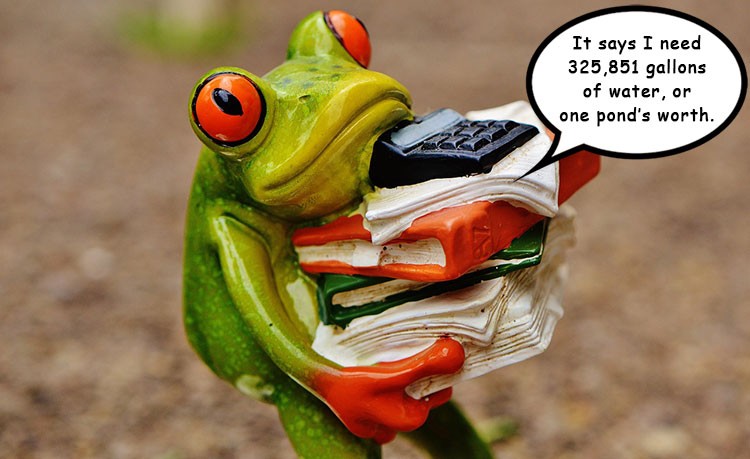14.7K

Key Points:
- The CDC recommends storing 1 gallon of water per person per day for emergencies.
- I recommend preppers store 1.5 gallons per person per day.
- Our water calculator can help you crunch the numbers on how much you need.
- Water is bulky and heavy, requiring careful storage planning.
How much water do you need to store? Water storage is not the sexiest thing to talk about when it comes to prepping, but it’s probably the most important. Exactly how much water should you store? I made a calculator to help answer that, but basically…
I recommend storing 1.5 gallons of water per person per day as a general guideline. However, that’s an exceptionally subjective number. It’s about like calculating how much ammo you need – more! The answer is always more.
“More” is not a helpful answer, however. If you’re like me, you want to plan your preps, not just go at it willy nilly. You save time and money by going about prepping strategically, by building a SHTF plan and then developing a plan to meet your needs should circumstances take a turn for the worse. “More” just means there’s never an end, and I like to feel like I’m making progress in my preps.
Water storage isn’t exactly as easy as just filling bottles, however…
Water takes up space!
See a few of the different water containers I have below. The SureWater tank on the left holds 260 gallons. The camping water jug in the middle holds 5 gallons. The Wurx container on the right holds 20 gallons.
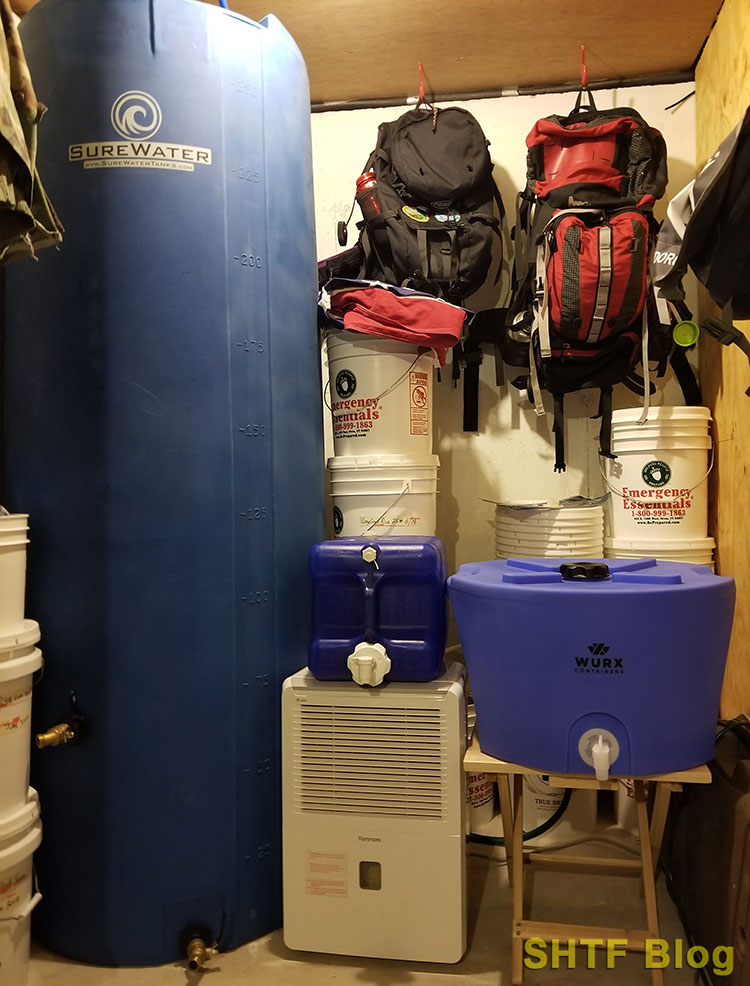
I’m fortunate to have the space to store water, but the space required makes “more” a particularly useless answer, because for most people, storage space quickly becomes an issue if you have lofty goals, i.e. you want to store months’ worth of water. If you live in a small house, or an apartment, it will be a challenge to store enough water for yourself – even more so if you have a family.
Picture your standard five-gallon fish tank. It’s not huge, but it takes up enough space that it usually demands its own designated space on a small table. Now imagine you want to store 50 gallons of water to start. You need ten of those tanks. Suddenly you’re looking around your home wondering… where!? How do you do this without turning your house into an aquarium?
Water is also heavy!
One gallon of water weighs 8.345 pounds. That same 50 gallons described above, not only are you now looking for space, but you’re looking for space that can easily hold 417.25 pounds (50 x 8.345). You can store bulk food on a closet shelf. That’s not going to happen with water. And if you get even heavier with more gallons, you’ll soon be looking exclusively at floor space in basement or on a concrete slab.
I don’t blame you if you’re now thinking this isn’t worth it, I’ll go back to building my bug out backpack. That’s certainly more fun, but before you do that, let me explain why overlooking water storage is such a bad idea.
Water Calculator
Here’s the calculator. Plug in your assumptions, check your results, and then lets dig further into this subject of how much water you should store.
5 Reasons Every prepper Should Start Storing Water
I make the case why every prepper should start their supplies with water in prepper–supplies/”>my prepper supplies article. The general gist lies in the following concepts.
#1 – Loss of Clean Water is Common in Disaster Situations
Post-disaster, clean water is going to disappear – and this could happen overnight. We currently live in a society where water is ever present, and for many, we’ve come to take access to clean water for granted.
However, after many natural disasters, clean water is often the first thing to go. I emphasize “clean” because there is usually still water available – somewhere. In fact, in the case of a flood, the problem is too much water! But anyone that’s been around a flood or two knows the influx of water often contaminates drinking water and results in boil water advisories.
According to the University of Nebraska-Lincoln Institute of Agriculture and Natural Resources:
Floodwaters can fully inundate water wells for days or weeks. The force of floodwaters can also disrupt or damage well or water supply infrastructure and directly introduce the contaminated water into the well.
Beyond floods, water often becomes a problem when the power goes out. If you have a well pump you need a generator to draw from it. If you’re on public water it should still flow as the stations have generators. If the power goes out for good (think EMP), you’re out of luck. You’re left with the natural water that might be around you outside, or what you have stored. If it’s a drought, things are even worse.
#2 – Biological Need – Hydration
Perhaps the most obvious reason to start your water storage is because we all need water to stay alive! Humans can only go a three days without water, and even attempting to get that far without it is going to be miserable. If you’re outside doing strenuous work in the sun, going without enough water will lead to headaches, irritability, and heat-related injuries.
#3 – Cooking
If you’re going to cook post-disaster (and you are), then you need to have water set aside for washing foods and boiling food. preppers are known for their storage of beans, bullets, and band-aids, but have you ever tried to eat dried beans without water? You can’t.
Whether we’re talking about the sacks of rice, beans, flour, lentils, or whatever other dried goods you’ve been storing, you’re going to need some way to make those foods edible, and means water.
Even if you think you’re just going to live off MREs in the aftermath of a disaster (they’re not as healthy as you think), you still need water to activate the chemical heater. What’s more, all of that survival–food-deals/” target=”_blank” rel=”noreferrer noopener”>freeze-dried survival food you bought, that will need water to become rehydrated.
#4 – Cleaning
When the power goes out, it’s not a big deal to go without a shower for a day, but remembering the Maine ice storm of of 1998, when freezing rain fell for about 50 hours resulting in about 200,000 reports of power outages, it took up to 20 days for some parts of the state to get power back. People were stealing generators. Any restaurant with power was flooded with people looking for a hot meal. Many ended up renting hotel rooms just to get a hot shower.
On my backpacking trips, I can make it about a maximum of 2-3 days before I need to find some way to clean myself. Any longer than that and I’m feeling pretty gross. Granted those are exercise-filled, sweaty days, but proper hygiene is an must for post-disaster populations. Those who let that slip to the wayside are at an increased risk of contracting various ailments.
Beyond our bodies, in any type of grid down/collapse situation, we will eventually need to clean our clothes. We’ll need to clean our dishes. We’ll need to clean surfaces. In other words – we’ll need clean water.
#5 – Water is an Easy (and Free) Place to Start
When it comes to prepping, there’s really no reason not to start with water. Before disaster hits, you can find it just about everywhere, and the best part is, it’s either incredibly cheap or entirely free! Just turn on your tap and start storing. You will immediately have a sense of prepping progress as you stack stored water.
How Much Water Do You REALLY Need to Store?
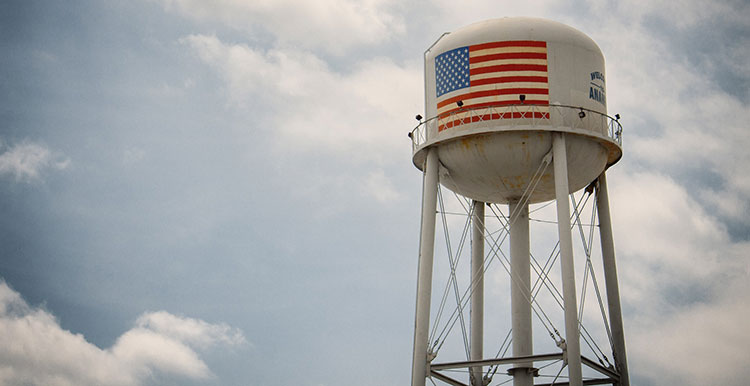
If you don’t like my advice of 1.5 gallons per person per day, that’s quite fine. It’s not a standard that is going to work for everyone, let alone one that everyone can agree on. If you want to come up with your own metric to determine how much you should store, you have to figure out how much water you really need?
To answer that question, you need to figure out two things:
- How much water you use today
- Where you’re willing to cut water consumption during a crisis
How Much Water Do Americans Use?
According to the EPA, the average American family uses 300 gallons of water per day at home. Roughly 70% of that is indoor use. If you figure the average family is a family of 4, that’s 75 gallons per person per day.
How can that be!? you might wonder. And here I am suggesting 1.5 gallons per day. Quite a difference!
Consider the average American home. We take long showers (sometimes baths), we wash clothes, we have dishwashers, we’re constantly flushing the toilet, we wash our cars, we water our lawns, the list goes on and on.
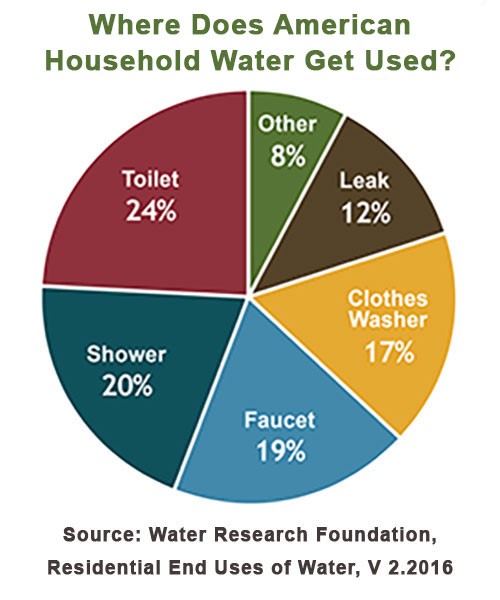
The 300 gallons number also accounts for all use, even indirect use, averaged out by family count. We’re indirectly using much more water than we think. The food we buy at the grocery store, there was water used to produce that. The energy used to power our homes, water went into that too.
So, you can see how much water is being used – a ton (1.25 tons per family to be precise (8.33lbs per gallon x 300 gallons = 2,499 pounds)). You can also begin to see how, in a disaster situation, our water consumption will drop off dramatically.
How Do We Cut Water Use in a Crisis?
There is nothing “normal” about a crisis. That’s what makes it a crisis, after all. So, you can throw that 300 gallons per family figure out the window. Here you’re going to look at exactly what you’re going to need water for, your direct and immediate consumption needs in a crisis.
This is made easier by crossing some “normal” water uses off the list:
- You will not be watering your lawn, washing your car, or anything like that.
- Assuming you can even run a clothes washer, you’re not going to need to wash clothes daily. A little grime on your jeans won’t be the end of the world.
- You can wash dishes by hand and save a lot of water over using a dishwasher.
- According to a 2016 study, we use roughly 17 gallons of water for an eight-minute shower. We won’t need daily showers after a collapse. Ever hear of a sponge bath? They’re not just for babies.
- Will you really have to flush your toilet that often? If it’s yellow let it mellow! Alternatively, dig a latrine for your poop and pee outside!
Focus on Your Water Needs
For planning purposes, rather than starting from where you can cut water, you can also start from where you must have water. This is going to come down to three core categories: hydration, cooking, and cleaning.
Hydration
How much water do you need to stay hydrated? That depends. How much do you weigh? What is climate are you living in? Are you engaging in physical labor? As a rough guide, consider this advice:
| Sex | Recommended Daily Water Intake |
|---|---|
| Female | 11.5 cups (0.72 gallons or 2.7 liters) |
| Male | 15.5 cups (0.97 gallons or 3.7 liters) |
Suddenly 1.5 gallons doesn’t seem like a lot, does it? Add in some cooking and some cleaning and you’re at that 1.5 gallon per person per day recommendation quite easily. If you have to account for a hot/humid climate and/or physical labor, the number starts creeping up rather quickly.
Of course, if you’ve ever tried to drink a gallon of water a day you know it’s not easy, but that is straight water consumption under normal circumstances. In a normal day you may also be drinking coffee, tea, soda, juice, etc. Cut all of those out and drink nothing but water and a gallon a day isn’t as difficult.
Cooking
Cooking requires water use as well. The standard for pasta, as an example, is 4-6 quarts of water per pound of pasta. That’s a minimum of 1 gallon of water to 1 pound of pasta.
We could cut the “standard” water-to-pasta ratio in a crisis, but just looking at freeze dried foods, where all of the water ends up absorbed in the food itself, you still need plenty of water.
Take as an example the two pictures below. I took these off some freeze-dried products I purchased from Emergency Essentials. The first is from a #10 can of white cheddar mac and cheese. The second is off single serving of their high protein vanilla shake mix.
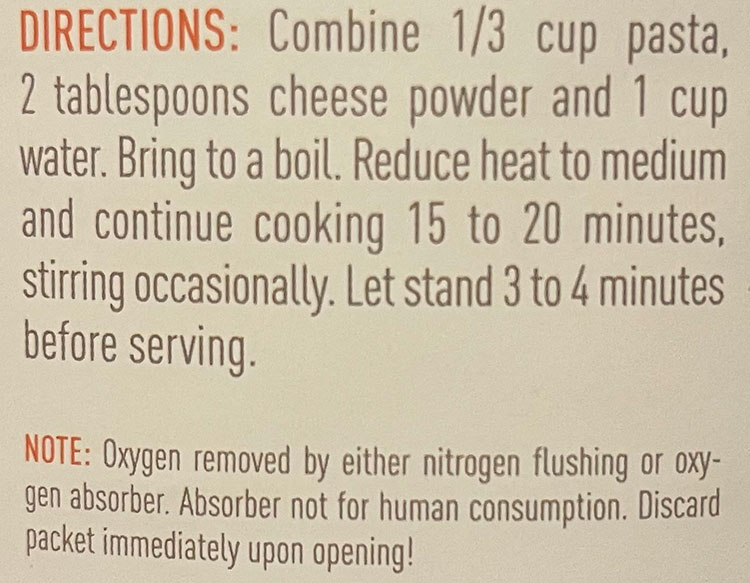
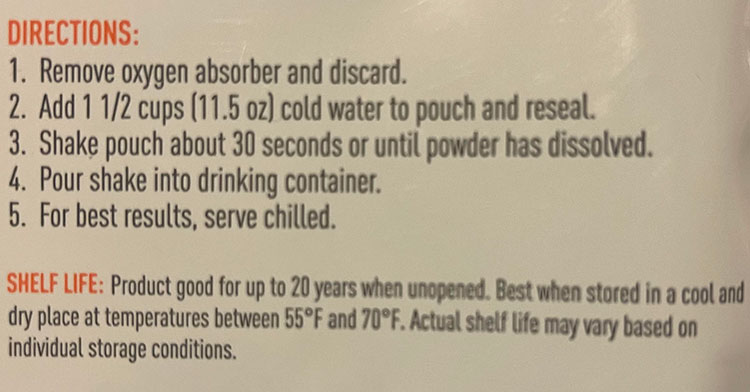
Arthur T. Bradley, bestselling author of the Preparedness-Family/dp/1475136536?&linkCode=ll1&tag=shtf08-20&linkId=230e0ab0352a219c26b7b35875847a8a&language=en_US&ref_=as_li_ss_tl” target=”_blank” rel=”noreferrer noopener nofollow”>Handbook to Practical Disaster Preparedness for the Family, puts his cooking/drinking number significantly lower. According to him, the average human can get by with just a gallon of water a day when it comes to both drinking and cooking. He seems to be following the CDC guidelines, and that “one per one” does make for an easy calculation.
There’s nothing wrong with starting with 1 gallon per person per day. Something is better than nothing, and if nothing else, that figure gets you 66% of the way to my recommendation.
Cleaning
This is where the water needs can add up. Investing in a five-gallon camping shower is a wise idea as a prepper. If we assume you’re only going to take 2 showers/week (and use the full 5 gallons), that’s 10 gallons per week. You can cut that showering assumption, as I mentioned, with a sponge bath, but… anyone with long hair might disagree.
Regardless, let’s also say that you’re going to use a third of a gallon/day for washing your hands, and another 1/3 gallon per day to wash dishes. Add that in.
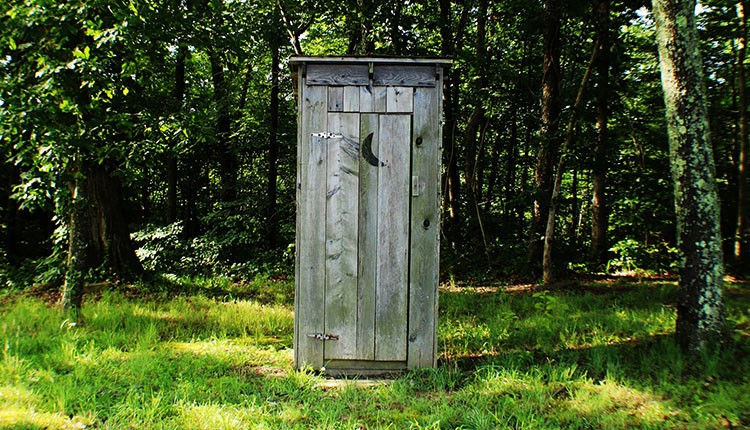
What about toilets? If you’re in a situation without power, you’ll have to pour water in the toilet tank as well. You don’t have to waste clean water on this though. If you can catch your used gray water (from showers, dish washing, hand washing, etc.) this water would be perfect for flushing.
Personally, I have a Luggable Loo for such a situation. Beyond the Luggable Loo, you could also build a latrine outdoors if you’re living somewhere rural.
In a short-term winter storm-type situation, sure, I’ll use water to flush a toilet. But in a grid down, EMP type SHTF situation – there’s no way I’m using clean water to flush a toilet. Pond water, stream water – those are options. You could also attempt to capture any shower water for flushing a toilet. In other words, you could find ways to get creative and in some cases, use water twice.
If we assume that we’re going to hand-wash our clothes once a week using a Scrubba, as an example, that makes another 7 gallons of water/week/person.
We can decrease overall water needs by taking fewer showers, using a compost toilet, using disposable plates and silverware, melting winter ice (now you’re stocking more fuel), and so on. My overall point here is that…
I Stand By 1.5 Gallons Per Person Per Day
Better to overprepare than underprepare, and 1.5 gallons per person per day – I think – is not overpreparing.
That said, I recognize that your results in the water calculator may seem intimidating. In fact, it probably is, but depending on where you live, you may have methods to augment this water storage with water collection strategies, drawing water from a pond, building a rain catchment system, etc. Still, it’s nice to have clean, potable water stored regardless.
Further reading? Check out The prepper’s Water survival Guide by Daisy Luther:
What are your thoughts? How much water do you have stored? Let me know in the comments section. Let’s bounce some ideas around
